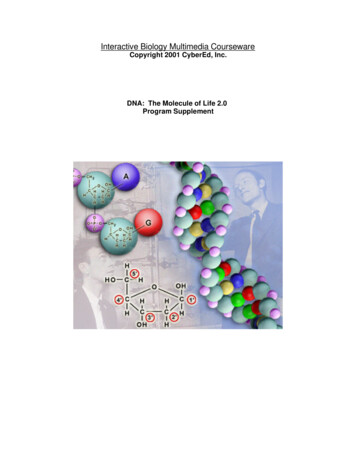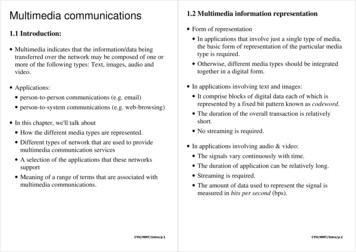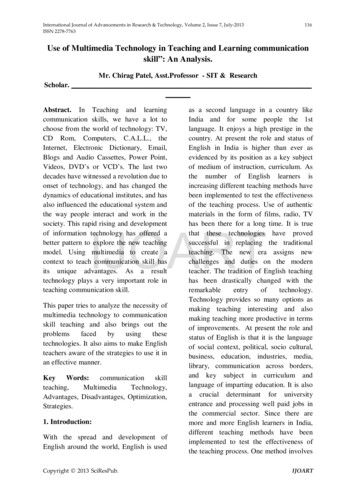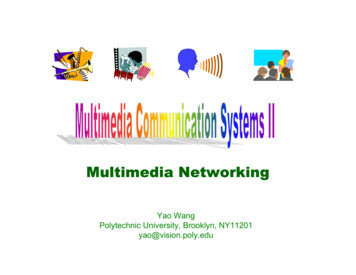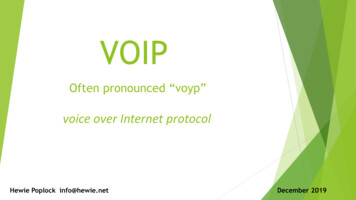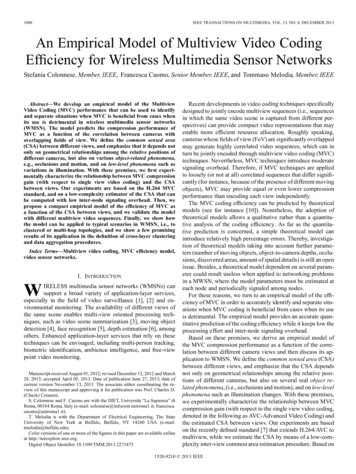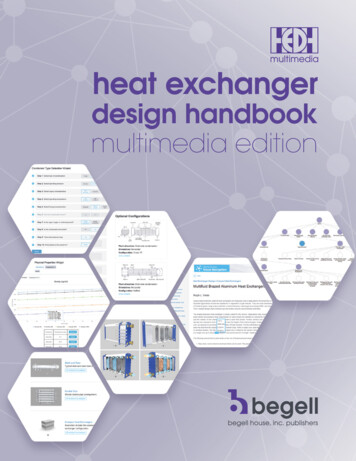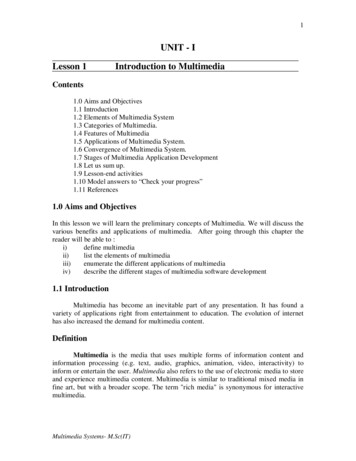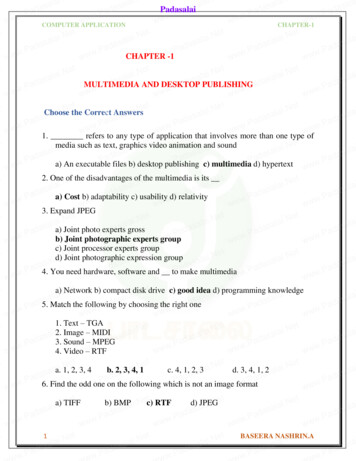
Transcription
2-4 February 2015- Istanbul, TurkeyndProceedings of INTCESS15- 2 International Conference on Education and Social Sciences368THE EFFECTIVENESS OF MULTIMEDIA COURSEWARE ON STUDENTS’COMPREHENSION OF TAJWEED AND RECITATION OF AL-QURANZABEDAH A.AZIZ1*, IRFAN NAUFAL UMAR21Universiti Sains Malaysia, zabedah aziz@yahoo.com2Universiti Sains Malaysia, irfan@usm.my*Corresponding AuthorAbstractThe purpose of this quasi experimental study is to investigate the effectiveness of multimedia tajweedlearning courseware on students’ comprehension and their recitation of Quranic verses. A multimediacourseware with three modes of presentation (multimedia with video mode, multimedia with video andsubtitle mode, and multimedia with voice recognition mode) was designed as the treatment. A total of 158students from six schools in Malaysia were involved in this study. A pre-test was administered to determinetheir level of comprehension of tajweed and their recitations of several Quranic verses involving the tajweedto be learned. After 140 minutes of treatment, a post-test was administrated to measure the effects of thetreatment. The post-test results showed an improvement in both the dependent variables – the students’comprehension of the tajweed as well as their recitations of the Quranic verses involving the learnedtajweed. The three modes of multimedia presentation ultimately showed positive impact on thecomprehension of tajweed and recitation of the Quran whereby voice recognition system was identified asthe most effective mode which allowed the students to record, playback and save the audio files.Keywords: Tajweed comprehension, al-Quran recitation, multimedia presentation modes1.0 INTRODUCTIONIn today’s era of computer technology, multimedia is widely known as one of the modern tools that are veryuseful in making our daily routines easier in many ways. According to Mayer (2001), visual and verbal arethe two multimedia elements that could bring the interest of the learners and activate their working memoryand the long term memory. Therefore, multimedia has been widely used as a learning material to supportteaching and learning.Multimedia is also used in teaching and learning of Islamic education. In the context of Malaysian education,there are numerous supporting learning materials such as multimedia courseware that have been distributedto the schools nationwide. However, according to the teachers and students, the courseware is only basedon documentary sources, not interactive and not challenging. Several researchers (e.g.: Rosmaria, 2003;Norasikin, Zawawi, Zarina, Siti Fadzillah & Khairuddin, 2005) found that none of the courseware that is usedin government schools promotes a better understanding of tajweed and the recitation of Quran.In Malaysia, the learning of Quran recitation has been taught from the early stage of primary school years (7years old or Grade 1) until the end of the secondary school (17 years old or Grade 11). However, somestudents are still having problems in reciting the Quran. In their study, Nasir and Rubiah (1999) found thatabout 35% students (n 80) are very weak while 38% (n 80) are moderate in understanding the tajweedrules and Quran recitation. There are two biggest problems faced by these students concerning Quranrecitation. The first one is the difficulties in understanding the tajweed rules due to the Arabic terms beingused (e.g.: the Idgham and Izhar terms; the names of the rules are quite similar to each other such as MadSilah Towilah and Mad Silah Qosiroh). Secondly is the difficulty to recite the Quran by following the correctflow of the tajweed rules.Due to these problems, there is a need to develop a learning courseware that gives a better understandingof tajweed rules and demonstrate the correct way to recite the Quranic verses (also called kalimah).Furthermore, the authors have also developed the multimedia with three modes of courseware to investigatethe effect of this courseware on Malaysian secondary school students’ comprehension of the tajweed rulesand their recitations of the Quranic verses.ISBN: 978-605-64453-2-3
2-4 February 2015- Istanbul, TurkeyndProceedings of INTCESS15- 2 International Conference on Education and Social Sciences3692.0 THREE MODES OF MULTIMEDIA2.1 Multimedia with Video (MV)MV is a presentation that combines multimedia elements such as text, graphics, audio, video andinteractivity. In this courseware, the video shows an expert reader or qari reciting the kalimah. The text orkalimah recited by the qari was placed outside of the video frame. Figure 1 shows an example of the MVinterface.Fig. 1: The Interface of MV2.2 Multimedia with Video and Subtitle (MVS)MVS is also a presentation the combines multimedia elements such as texts, graphics, audio, video andinteractivity. This mode is different with the MV mode in that this MVS is using the same language subtitleconcept, and when the qari recites the kalimah, the text color of the recited kalimah will be changed.Figure 2 shows the interface of MVS.Fig. 2: The Interface of MVS2.3 Multimedia with Voice Recognition (MVR)MVR is also a multimedia presentation that adapts the same template as MV. However, the MVR brings adifferent feature whereby the presentation was embedded with small system of voice recognition thatallows the user to: (i) record, (ii) playback, and (iii) save the audio file. In other words, after listening to theqari’s recital from the video, the student is allowed to record his/her recitation of the kalimah, save it andplay it back. Figure 3 shows the interface of MVR.Fig. 3: The Interface of MVRISBN: 978-605-64453-2-3
2-4 February 2015- Istanbul, TurkeyndProceedings of INTCESS15- 2 International Conference on Education and Social Sciences3703.0 RESEARCH QUESTION1. Which is the best multimedia mode in increasing the students’ comprehension of tajweed rules?2. Which is the best multimedia mode in increasing the students’ Quran recitation?4.0 METHODOLOGYA total of 158 Form 2 or Grade 8 (14 years old) students from three secondary schools in a northern state ofPeninsular Malaysia participated in the study. A pretest of understanding the tajweed rules and a pretest ofal-Quran recitation have been carried out to investigate the students’ prior knowledge before they undergothe treatment. The pretest score was later used as the covariate when analyzing the differences in terms ofposttest scores among the three treatment groups using ANCOVA. The students took about 140 minutes tocomplete the treatment, i.e., learning from the multimedia courseware. After they have completed thetreatment session, the three groups sat for the two posttests in order to measure their comprehension of thetajweed rules as well as to measure their al-Quran recitation. A written test was administered to measure theparticipants’ comprehension. Each student was also required to recite the Quranic verses involving thetajweed rules learned from the courseware, and the teacher graded the student’s recitation.5.0 FINDINGSIn order to answer the first research question, the pretest of the students’ comprehension on the tajweedrules was used as covariate. The adjusted mean sore for the post test is 8.00. Based on Table 1, thestudents who received the MVR treatment obtained the highest mean score (mean: 28.57), followed by thegroup using MVS (mean: 23:50) and MV (mean: 18:13). The ANCOVA result indicates a significantdifference in terms of tajweed comprehension between the three modes of treatment groups at the 0.05 levelof significance (F: 898, p: 0.00).The post hoc results in Table 2 indicate that MVS group obtained significantly higher score compared withthe MV group (p: 0.032, the mean difference: 5.38). The MVR group also performed significantly bettercompared to the MVS group (p: 0.047, the mean difference: 5.06). A significant difference was also foundbetween the MVR and the MV groups (p: 0.00, mean difference: 10:44). Therefore, MVR obtained thehighest score, followed by the group and finally the MV group. It other words, the finding shows significantdifferences in terms of tajweed rules comprehension between the MVR, MVS and the MV groups, with theMVR group obtained the highest score, followed by the MVS group and finally the MV group.Table 1Result of Posttest of Comprehension of Tajweed Rules for the Three Modes of PresentationGroupMVMVSMVRN464648Adjusted 0Sig.Table 2Result of Post Hoc of Comprehension of Tajweed RulesPost ig.Sig.In order to answer the second research question, the pretest scores of Quran recitation were used as thecovariate. The analysis revealed the adjusted means of the post test at 20.68. Based on Table 3, the MVRgroup obtained the highest recitation score (mean: 34.50), followed by the MVS group (mean: 30.25), andthe MV group (mean: 30.15). The ANCOVA univariate analysis showed a significant difference in terms ofQuran recitation among the three treatment groups at the 0.05 level of significance (F: 5.797, p: 0.004).The post hoc results in Table 4 indicate that the MVR group performed a significantly higher recitation scoreas compared to that of the MVS group (p: 0.005, mean difference: 4.25). A significant difference was alsoobserved between the MVR and MV groups (p: 0.003, mean difference: 4:35), with the former outperformedISBN: 978-605-64453-2-3
2-4 February 2015- Istanbul, TurkeyndProceedings of INTCESS15- 2 International Conference on Education and Social Sciences371the latter group. In addition, although the MVS group obtained a higher recitation score compared to the MVgroup (mean difference: 0.98), the comparison between these two groups yield a non-significant finding (p:0.945). Thus, overall, it can be concluded that there are significant differences in Quran recitation betweengroups of students who received the MV, MVS and MVR courseware.Table 3Result of Posttest of Quran Recitation for the Three Modes of .2534.50SEFpResult0.981.011.015.7970.004Sig.Table 4Result of Post Hoc of Quran RecitationPost HocRecitationof 35pResult0.9450.0050.003Not Sig.Sig.Sig.6.0 DISCUSSIONData analysis shows that there is a significant difference in comprehension in the tajweed rules among thegroups who received the three different presentation modes; MV, MVS and MVR. The post hoc findingindicates that the MVR group obtained significantly higher comprehension score as compared to the MVSand MV groups. This result showed that the elements in the MVR interface have stimulated the students’comprehension of tajweed rules as compared to the other two modes. The voice recognition system thatallows students to record, playback and evaluate their own recitation is an advantage that could help them tounderstand more about tajweed rules. During learning, the students in the MVR group indirectly perform atype of self-assessment when they playback their own voice recording (their own recitation of the Quranicverses) and the compared it to the qari’s recitation. According to Mohd Azizi and Isha (2008), when studentscan assess and reflect their own work, they can eventually analyze their own progress, identify theirstrengths and weaknesses, and try to improve their work.The implications of self-assessment can provide intellectual stimulation by establishing learning experience(Valkanova, 2004). Self-evaluation enhances the learning autonomy and encourages students to do better(Chen, 2008). In regard to MVS, the subtitle only helps the students to follow the recitation from the qari butthe students did not perform any self-assessment. This is due to the fact that no recording of the student’srecitation is done in this courseware mode, and thus, the absence of any audio files that can be played backand be compared it to the qari’s recitation. Furthermore, the students who had undergone the MVS treatmentultimately lost their focus on the tajweed rules as they were too eager to follow the recitation of the qari andthe color changing of kalimah. Meanwhile, the students who received MV were having problem in focusing tothe video and qari at the same time. This problem occurred due to the split attention principle - students willhave problems in learning when they had to divide their attention to several elements exist in the media(Moreno, 2006).7.0 CONCLUSION AND SUGGESTIONBased on the findings, it can be concluded that multimedia courseware for teaching the holy Quran shouldbe more interactive and provide more opportunity for students to learn at their own self-paced. Selfassessment helps students to find their own mistakes and try to do improvement on their own. Students willbe able to understand more about tajweed rules as well as improve their Quran recitation when they doreflection and self-assessment of their own recitation in the audio files recorded. Moreover, voice recognitionis one of the many ways to help students produce a smooth Quran recitation. Further research should bedone in the field of voice recognition as it has the capability to improve the memorization of the Quranicverses and Arabic writing.ISBN: 978-605-64453-2-3
2-4 February 2015- Istanbul, TurkeyndProceedings of INTCESS15- 2 International Conference on Education and Social Sciences372REFERENCE LISTAzizi Ahmad & Mohd Isha Awang. (2008). Measurement and evaluation in education. (4Lumpur: Meteor Doc. Sdn. Bhd.thEd). KualaChen, Y.M. (2008). Learning to self-assess oral performance in english: A longitudinal case study. LanguageTeaching Research, 12 (2), 235-262.Rabiner, L. (1989). A tutorial on hidden markov models and selected applications in speech recognition.Proceedings IEEE Conference, 77 (2), 257-287.Kothari, B. (2008). Let a billion readers bloom: Same language subtitling (SLS) on television for massliteracy. International Review of Education, 54, 773-780.stMayer, R. E. (2001). Multimedia learning (1 Ed). New York: Cambridge University Press.Moreno, R. (2006). Does the modality principle hold for different media. A test of the method-affects-learninghypothesis. Journal of Computer Assisted Learning, 22, 149-158.Nasir & Rubiah. (1997). Tahap penguasaan bacaan al-Quran di kalangan guru pelatih bukan om/koran.htmNorasikin Fabil, Zawawi Ismail, Zarina Shukur, Siti Fadzillah Mat Noor & Khairuddin Omar. (2005). Aplikasipendekatan talaqqi dan musyafahah dalam pembangunan perisian multimedia tajwid. Al-Bayan Journalof Al-Quran & al-Hadith, 3, 83–108.thPallant, J. (2010). SPSS Survival Manual. (4 Ed). Australia: Allen & Unwin Book Publishers.Rosmaria Mohd Sahat. (2003). Penggunaan komputer dan multimedia dalam pendidikan di Malaysia.Laporan Kajian Bebas Falkuti Pendidikan, Universiti Kebangsaan Malaysia.Valkanova,Y., Watts, M. & Jackson, A. (2004). Echancing self-reflection in children: The use of digital videoin the primary science classroom. Journal of eLiteracy, 1, 42-55.ISBN: 978-605-64453-2-3
tajweed rules as well as to measure their al-Quran recitation. A written test was administered to measure the participants' comprehension. Each student was also required to recite the Quranic verses involving the tajweed rules learned from the courseware, and the teacher graded the student's recitation. 5.0 FINDINGS

